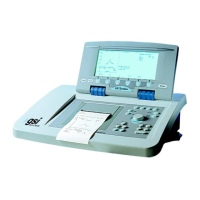Chapter 3
9) A cursor line approximates the resonance point of the ear along
the
Hz axis.
A) CURSOR left and right arrow softkeys may be used to specify a
different Hz point for
D
Y, B, or G values and
Dq
.
Press SET Hz
softkey to record
the new value.
B) Cursor position now determines probe frequency for next tymp.
10) Press CONTINUE to display tymp format for TEST 3 of the series.
11) Press START or CONTINUE to obtain a tymp at this probe frequency.
A) Tymp data is displayed on screen for selected probe frequency.
B) Use CURSOR left and right arrow softkeys to specify and set peak
admittance and pressure.
12) Test sequence can be terminated by selecting STOP,
OR
13) Tymps can be obtained for frequencies below and above identified
resonance point of the ear. To select probe tone frequency for next
tymp:
A) Press
the
PROBE Hz softkey. Use up and down arrows to display
desired Hz
. Press SET Hz softkey to select probe tone.
Use
START or CONTINUE to run next tymp.
OR
B) Press DELTA DISPLAY softkey to return to delta display screen.
Cursor line indicates probe frequency from last tymp. Press
CURSOR to select new probe tone frequency.
Press CONTINUE
followed by
START or CONTINUE to begin next tymp.
14) Press STOP to end the test.
1)
Press the TYMP hardkey to place the instrument in the tymp diagnostic
mode.
2)
Press the EAR softkey to select the test ear.
3)
Select the AUTO SEQUENCE softkey to initiate the automatic sequencing
of tests.
4) The test sequence will automatically terminate upon completion of the
last test with test results automatically stored in memory.
5) Test results can be viewed by pressing the PAGE hardkey and can then
be printed by pressing the PRINT hardkey.
NOTE
The sequence of tests always includes Tymp 226 Hz, Y, and can be configured to
include or exclude Reflex Threshold and Reflex Decay tests.
Grason-Stadler

